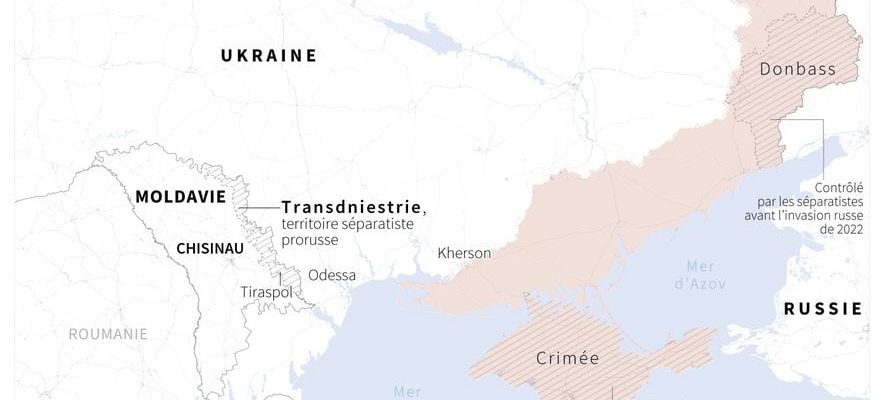Will this small territory in the southeast of Moldova, on the border with Ukraine, be a new war zone for Russia? This Wednesday evening, February 28, the authorities of Transnistria adopted an official declaration requesting the “protection” of Russia against Moldova, which recently adopted economic retaliatory measures against it. Transnistria faces “unprecedented threats of an economic, socio-humanitarian and military-political nature”, it is written in a statement.
Russian diplomacy quickly responded, ensuring that it had as a “priority” the “protection” of the inhabitants of Transnistria and adding that Moscow would “carefully examine” Tiraspol’s request, without giving further details. While the Moldovan government said it “rejected the propaganda” of separatist leaders and affirmed that the region benefited from “policies of peace, security and economic integration” within the framework of its links with the European Union.
The sequence of these events, however, is reminiscent at the current stage of the similar one in February 2022, when the appeal of pro-Russian separatists from Eastern Ukraine was then one of the pretexts put forward by Russian President Vladimir Putin. to launch a large-scale attack against this country. To better understand the implications of this declaration, L’Express takes stock of this little-known pro-Russian separatist region.
What happened ?
MPs from Transnistria met in Tiraspol, the capital, in an extraordinary congress, and called on the Russian Parliament to “implement measures to protect” their small territory where “more than 220,000 Russian citizens” live in the face of a ” increased pressure from Moldova. The separatist authorities have indicated that this congress, attended by 620 deputies, is a reaction to the recent introduction of customs duties by the Moldovan government on imports from Transnistria.
In his speech cited by the media, the local president, a pro-Russian, Vadim Krasnosselski, assured that this territory was undergoing “a policy of genocide”, via economic, “physical”, legal and linguistic pressures. In their resolution, MEPs also address the Organization for Security and Cooperation in Europe (OSCE), the European Parliament, the Red Cross and the UN General Secretariat, urging them to prevent “provocations” which could lead to “an escalation of tensions”.
What is Transnistria?
It is a narrow strip of land, just 200 kilometers long and 20 kilometers wide, located between Moldova and Ukraine. Transnistria, which officially has a population of 465,000, seceded from Moldova after a brief civil war. Predominantly Russian-speaking, Transnistria unilaterally proclaimed its independence in 1990, for fear of a “romanization” of Moldova, which was then seeking to leave the Soviet orbit. An armed conflict, which ended in July 1992, resulted in several hundred deaths and the intervention of the Russian army.
Transdniestria, pro-Russian separatist territory
© / afp.com/Valentin RAKOVSKY, Sabrina BLANCHARD
The territory along the Dniester is not recognized as a state by the international community, including Moscow, which considers it a bridgehead not far from the borders of the European Union. Russia also maintains 1,500 soldiers there, intended in particular to carry out a peacekeeping mission.
Who are the pro-Russians?
The two presidents that Transnistria has known, the current Vadim Krasnosselski, and the former Igor Smirnov (1991-2011), are pro-Russian. In a referendum in September 2006, the result of which is not recognized by the international community, the territory voted 97.1% for its attachment to Russian territory. The territory is highly economically dependent on Russia, which supplies it with free gas. Its economy is based on heavy industry and multiple traffic, particularly from the Ukrainian port of Odessa, but the standard of living remains very low. The “Sheriff” group, founded in the early 1990s by two former Soviet police officers and regularly accused of corruption, enjoys a virtual economic and political monopoly in Transnistria.
Since the start of the Russian assault in Ukraine two years ago, fears of a widening of the conflict to Transnistria have surfaced several times. Conjectures regularly resurface about a possible Russian attack from Transnistria towards the large Ukrainian port city of Odessa, on the Black Sea. Last year, the authorities of this self-proclaimed state notably accused kyiv of wanting to attack it after claiming to have foiled an attack in March that targeted its leaders. The Russian Defense Ministry again assured last week, without presenting evidence, that Ukraine was preparing an “armed provocation” against Transnistria.
What are the reactions of the international community?
Ukrainian diplomacy warned on Wednesday against any “destructive external interference” in Transnistria. The Ukrainian Foreign Ministry called in a statement “for a peaceful resolution of economic, social and humanitarian issues between Moldova and Transnistria, without any destructive external interference”, a barely veiled allusion to Russia.
In Washington, State Department spokesman Matthew Miller said that “the United States strongly supports the sovereignty and territorial integrity of Moldova within its internationally recognized borders.” The first European country to officially react, Poland, through its Prime Minister Donald Tusk, deemed the tensions in the region “dangerous”.
Earlier in the day, Ukrainian President Volodymyr Zelensky, in Albania for a summit of leaders of Southeast European states, said he had met his Moldovan counterpart Maia Sandu, with whom he discussed “recent developments in the Moldovan region of Transnistria, Russia’s efforts to destabilize the region and effective means to counter the harmful influence of the aggressor state.
